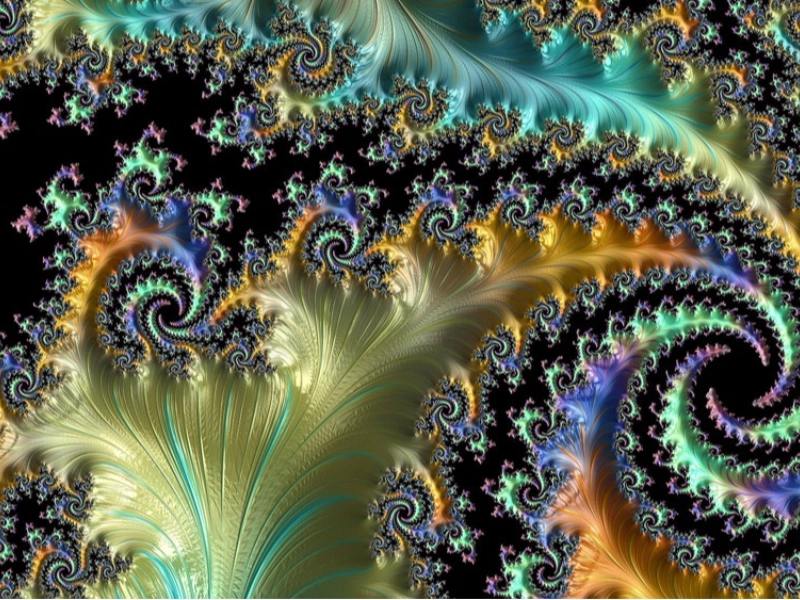Fractal Geometry: The Infinite Beauty of Repetition in Nature
Advertisement
4. Fractals in Art and Design: Blending Mathematics with Creativity

Advertisement
Not only have the captivating patterns and limitless complexity of fractals enthralled mathematicians and physicists, but they have also motivated designers and artists working in many fields. Fractal geometry's inclusion into art and architecture has produced creations that are both aesthetically beautiful and intellectually interesting by means of an amazing junction of mathematics and creativity.
Within the visual arts, fractal- Inspired works have become somewhat well-known. Using computer algorithms to create complex, vibrant images that seem to whirl and repeat indefinitely, artists like Carlos Ginzburg and Kerry Mitchell have produced whole collections based on fractal patterns. These pieces challenge spectators to find order in seeming anarchy, therefore blurring the border between art and mathematics.
Fractal art appeals because it can produce intricate, organic-looking structures from basic mathematical ideas. Many viewers on a subconscious level would relate to this since we are always tuned to see trends in our surroundings. Because the patterns remind us of natural shapes while their infinite complexity widens our view, fractal art often elicits both familiarity and amazement concurrently.
Fractal ideas have also been incorporated in architecture; several contemporary buildings use self-similar parts at varying sizes. Designed by Eric Owen Moss, the Los Angeles Siegel & Gale building exhibits a façade with repeating triangular designs that give a fractal-like look. Comparably, the Beijing National Stadium, sometimes referred to as the "Bird's Nest," features a sophisticated network of steel beams with a self-similar arrangement seen from several angles.
Fractal ideas are applied in landscape design to produce parks and gardens reflecting the natural organic complexity. From the general concept down to the placement of individual plants, designers can create natural and harmonic environments by including self-similar features at many levels. These designs' fractal character sometimes adds to their visual attractiveness and may even help guests have better psychological experiences.
Fractals have not been without appeal in the realm of fashion. Fractal patterns have been included into textiles and apparel designs by designers to produce complex, repeating themes. From subdued, nature-inspired motifs to strong, computer-generated fractals with a striking visual impact, these trends can span subtlety.
Fractal design ideas have become quite helpful tools in the digital sphere for producing realistic computer-generated imagery (CGI). Fractal algorithms are used in film companies and video game creators to create lifelike environments, clouds, and other natural features. Fractals' self-similarity makes it possible to create very finely detailed worlds that remain realistic even when the observer approaches or distances away.
Fractal-inspired components are used often in logo design and branding by graphic artists. From small icons to massive billboards, fractal patterns' scalability makes them perfect for logos needing to look excellent at many sizes. Though their logos are not exactly fractal, companies such as Walt Disney and Twitter combine characteristics of scalability and self-similarity.
Likewise, fractal ideas have shaped music. Using self-similar patterns to musical construction, some composers have experimented with producing "fractal music." As listeners focus on various musical scales, this might produce layered songs revealing fresh patterns and relationships.
Beyond simple beauty, fractals' inclusion into art and design has great influence. It reflects a more general trend of inspiration coming from the mathematical ideas guiding natural shapes. This method not only produces aesthetically pleasing works but also promotes a greater respect of the structures and patterns all around us in the natural environment.
Furthermore, fractals' application in design and art frequently acts as a link between public knowledge and scientific ideas. By making difficult mathematical concepts more understandable and interesting for a broad audience, fractal art helps to increase respect of mathematical beauty.
Fractal geometry's creative uses in art and design should only get more inventive as technology develops. Technologies related to virtual and augmented reality, for example, provide fresh opportunities to produce immersive fractal-based experiences that blur the boundaries between mathematics, art, and reality.
Fractals and creativity show how closely science and art may interact to inform and enhance one another. They are not isolated spheres. Artists and designers who embrace fractal geometry are not only producing aesthetically beautiful works but also asking us to view the world through a fresh lens that uncovers the underlying patterns and endless complexity in the apparently basic and familiar.
You May Like
Advertisement

